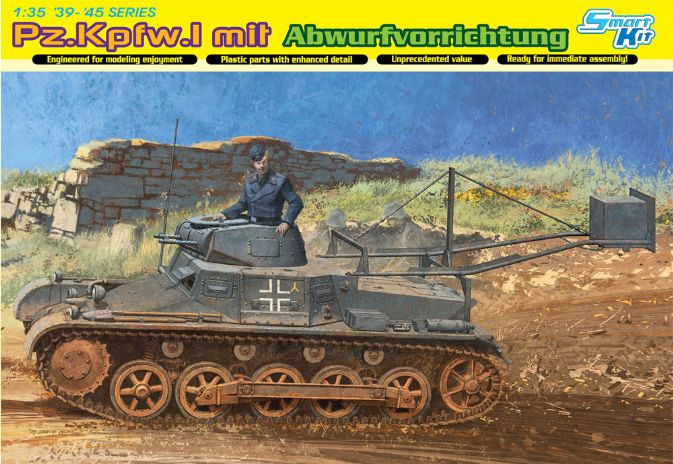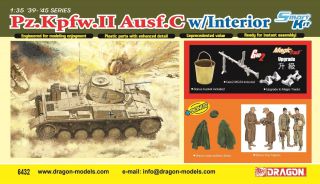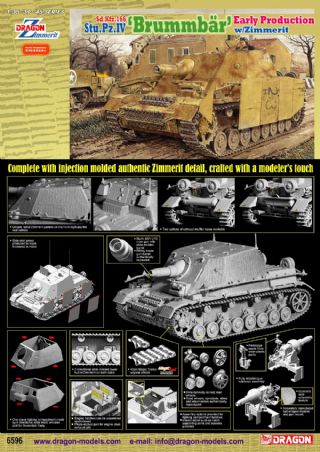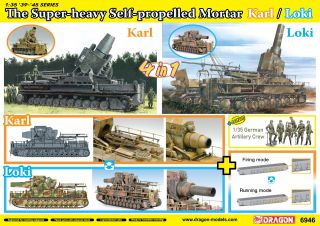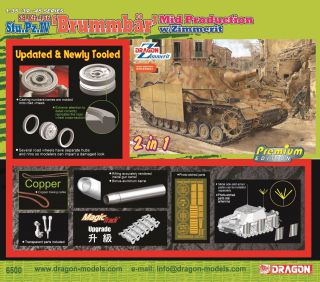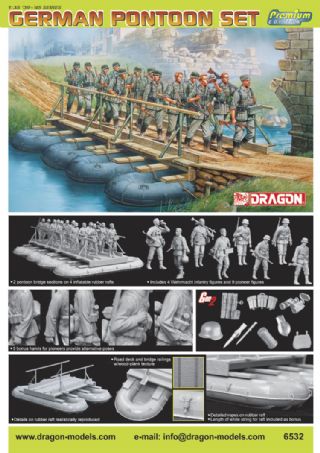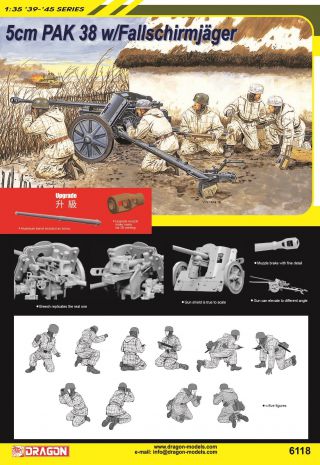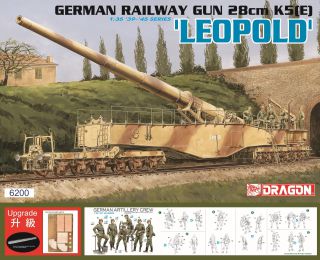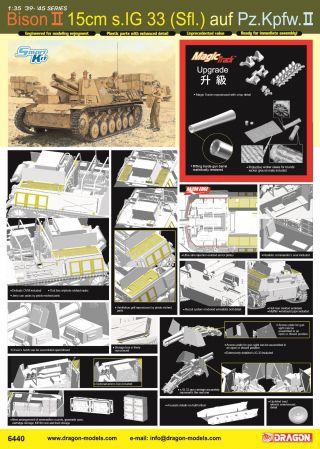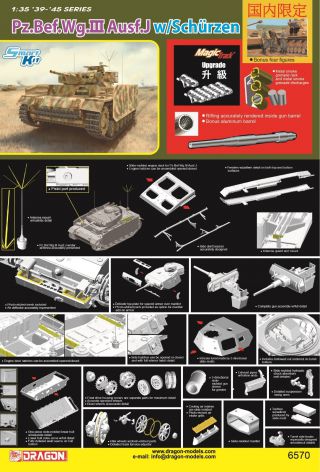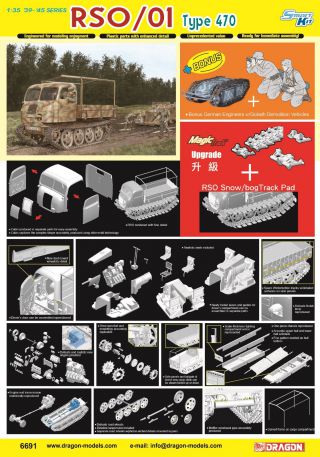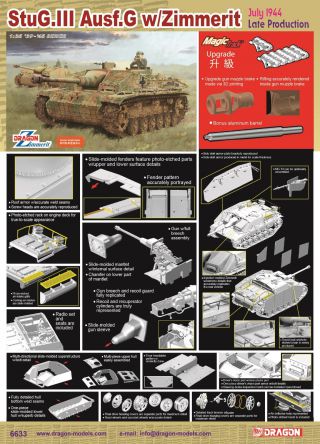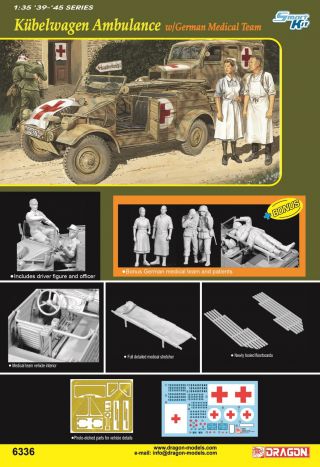HOME → Dragon Plastic Model Kits → 1/35 WWII Military → 6480
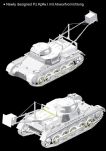

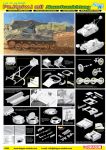





Barcode: 0 89195 86480 1
Case Pack: 20 kits
Box Size: 9.6" x 15" x 2.4"
Features:
- Newly designed Pz.Kpfw.I mit Abwurfvorrichtung
- Intricate spring molded on the bottom of Abwurfvorrichtung
- New Abwurfvorrichtung represented
- Cover of Abwurfvorrichtung can be assembled open/closed
- Upper hull w/authentic
- Idler wheels w/accurate detail
- Road wheels w/photo-etched rings
- Suspension system realistically represented
- Side fenders w/detailed tread pattern
- Lower hull formed from multiple parts for greater detail
- Accurately modeled glacis plate w/removable transmission inspection cover and accurate bolt detail
- Fighting-compartment access hatch can be assembled open/closed
- Turret roof hatch can be assembled open/closed
- Gun assembly is movable
- Multi-directional slide-molded turret w/accurate bolt detail
- Suspension w/coil spring in fine detail
- Air-intake grill reproduced like the real one
- Engine deck exquisitely detailed
- Engine hatches can be assembled open/closed
- Driver's vision port cover can be assembled open/closed
- Turret vision port cover can be assembled open/closed
- On-vehicle tools w/molded-on clasps
- Magic Tracks w/accurate detail
As Germany attempted to rearm in the 1930s in the lead-up to WWII, the military leadership relied heavily on the Pz.Kpfw.I. Some 1,493 examples of all types were built and these light tanks served in early campaigns even though they were supposed to be just training platforms. Mass production of the Ausf.A commenced in 1934, while the improved Ausf.B with a different engine appeared in August 1935. The Ausf.B was lengthened and it had five road wheels per side. The Panzer I was thinly armored with just 13mm steel at its thickest point. It operated with a crew of two – the commander/gunner and driver. An unusual version of this small tank was the Abwurfvorrichtung, literally a Demolition Charge Layer. These modified tanks were typically found in the panzer-pionier-bataillon of panzer divisions in 1940 in time for the campaign in Western Europe. The conversion comprised a device mounted on the rear deck that could lower a 50kg explosive charge onto or against a field fortification before it was then detonated.
Dragon is offering a fine 1/35 scale Smart Kit of a Panzer I Abwurfvorrichtung. This kit utilizes high-quality components from previous Pz.Kpfw.I Ausf.B kits, and mixes them with a range of brand new elements specifically produced for the Demolition Charge Layer. The kit employs multimedia materials such as plastic and metal cables in order to recreate this exact variant. It's convenient too - the track links may be tiny but they're perfectly produced via Magic Tracks with no need for time-consuming cleanup. The Abwurfvorrichtung may seem like an insignificant or unusual subject for a kit, and surely modelers never dreamt they'd see one produced by a mainstream kit manufacturer. However, Dragon always seeks to surprise and satisfy modelers, and this kit does exactly that!
Review:
Kit Review: Dragon Models Limited 1/35 Scale ‘39-‘45 Series Kit No. 6480;
Pz.Kpfw. I mit Abwurfvorrichtung - Smart Kit;
554 parts (244 in grey styrene, 216 “Magic Track” single links, 51 etched brass, 41 clear styrene, 1 twisted steel wire, 1 nylon string);
preorder price US$49.95 via Dragon USA Online
Advantages: upgraded version of the 2004 kit with new parts from the better
molded A version where applicable; interesting version with charge layer equipment
Disadvantages: very tiny individual track links will not be popular with some
modelers
Rating: Highly Recommended
Recommendation: for all light armor, armored engineer and German armor fans
F I R S T L O O K
When armored vehicles first appeared in WW I it did not take the engineers long
to realize these vehicles had a lot of advantages in carrying out tasks which
would otherwise place them at risk. While few experiments were carried out during
the war, in the postwar period some experiments were conducted.
Most countries came to the conclusion that a tank could be used to place a charge
next to an obstacle that was covered by enemy fire, and so experiments concentrated
on a way to get the charge next to the objective. This vehicle was among the
first created by the Germans to do this and was used during WWII for laying
explosive charges. The idea was that the tank, in this case the little Panzer
I, would approach the objective, turn around, drop its charge next to the objective,
drive off, and then remotely detonate the explosives to flatten the objective.
Two versions were developed, one with a long arm holding the case with the explosive
charge and one with a “ski jump” that simply let it slide off the rear of the
tank. Up to 10 of these devices were fitted to tanks assigned to the 3rd company
of the armored Pioneer engineer battalion of panzer divisions. (There is no
information apparently on how many were converted.)
But the Panzer I was not the most reliable vehicle to use for this as it was
thinly armored and unless given plenty of cover and supporting attacks, it was
easily knocked out before it could place its charge. The Soviets preferred vehicles
like the KV-2 with a 152mm howitzer and the British the Churchill AVRE for the
same purpose, as both had thick armor and could flatten the objective with either
a shell in the case of the former or a “dustbin” charge from the latter’s mortar.
DML has now offered a kit of the first variant of this interesting concept and
based it on an upgraded version of their Panzer I Ausf. B kit from 2004. The
kit has had any of its common parts with the Ausf. A replaced by sprues from
the later (and better) A kits as well as one new sprue with all of the charge
laying device components.
This kit comes with the complete set of clear styrene vision blocks and block
frames, which are used to provide the basis for the vision port mounts and also
the locks for opening the external vision ports.
But as this is a typical “mix and match” kit with sprues from previous kits,
the modeler must pay attention to the directions for which components go with
this model. (There are three different machine gun mounts for the turret as
an example.) Alas, the directions are confusing and leave some bits out, such
as the MB1 parts which are the brass stiffener rings for the road wheels.
All of the previous kit options on exhausts, hatches and view port covers have
been retained. As before, the kit includes 216 single track links, which are
not going to be popular with some modelers as they are very, very small – each
one is about 3 mm x 7 mm. At least this kit uses the improved “Magic Track”
set so you don’t have to remove the links from sprues as with the original B
kits.
The charge laying container comes with separate lids and a possible diorama
option would be showing engineers packing it with explosive charges.
Technical advice came from Tom Cockle and Gary Edmundson.
Two different finishing options are offered: 1st Panzer Division, 1940 (panzer
gray with white crosses and markings), and Unidentified Unit 1940 (panzer grey,
white crosses and white 323). A small sheet of Cartograf decals is incldued.
Again, this is an interesting version of a vehicle which did see service (hence
not a cyber-hobby.com effort).
Thanks to Freddie Leung of DML for the review sample.
-Cookie Sewell-

